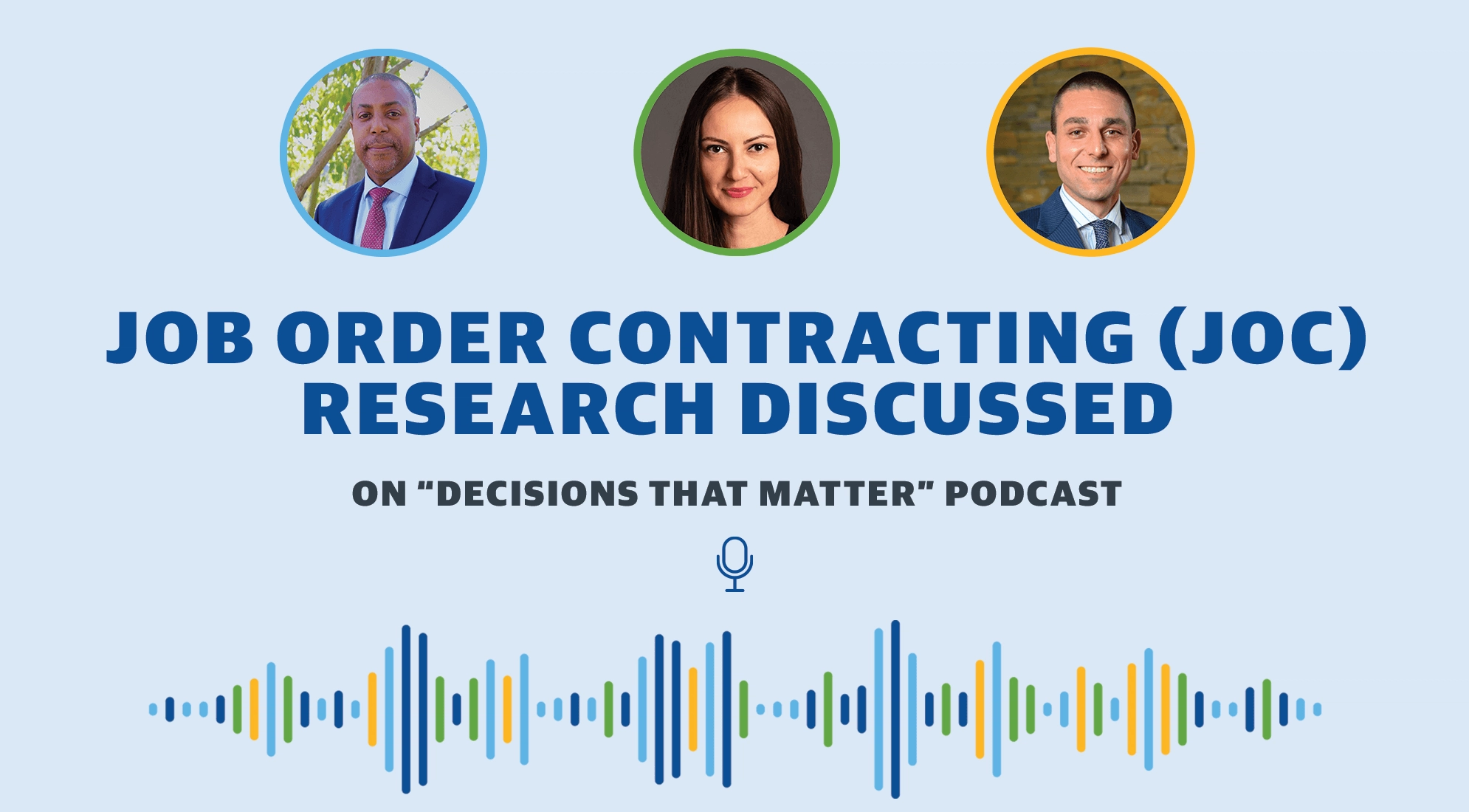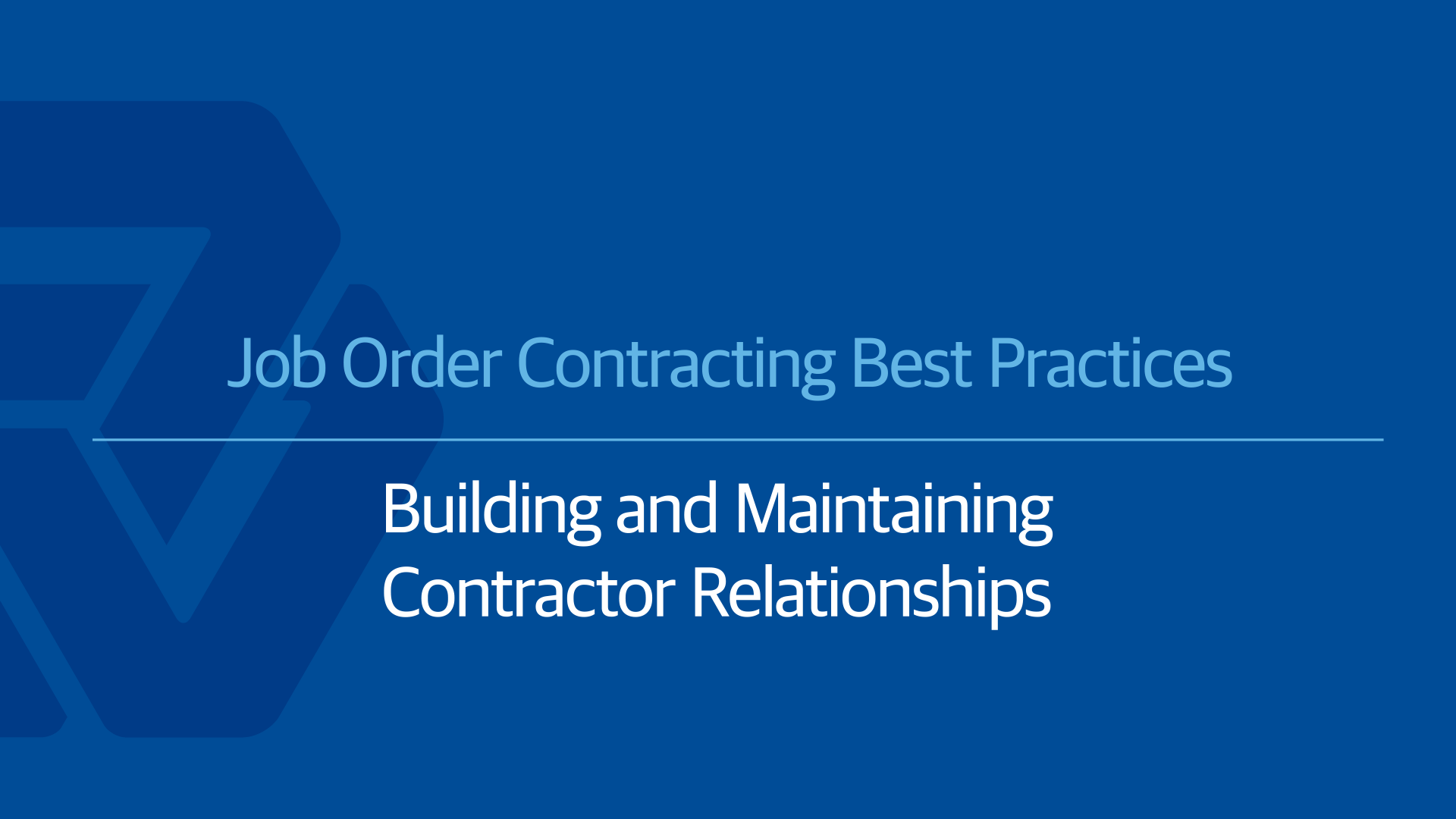
Job Order Contracting Research Discussed on “Decisions That Matter” Podcast
June 18, 2024
Procurated’s “Decisions That Matter” podcast shed light on exciting new research into Job Order Contracting as a project delivery method. Researchers Andrea Patrucco, Ph.D. and Ana-Maria Dimand, Ph.D., Gordian Director of Business Development for the Western Region Randy Horn, and co-hosts Alex Stonehouse and Bernadette Launi discuss the Job Order Contracting research and its implications for public sector construction procurement. Listen to the entire interview below.
Partial Interview Transcript
Alex Stonehouse, Procurated: Just to get started, I want us all to start with a common definition of Job Order Contracting (JOC). So, Randy, would you mind telling us how you would define Job Order Contracting so everyone listening knows exactly what we’re talking about?
Randy Horn, Gordian: Job Order Contracting is a unique, indefinite delivery/indefinite quantity (IDIQ) procurement process that helps facility and infrastructure owners complete repair, maintenance, renovation and straightforward new construction projects through a competitively-awarded contract. Unlike traditional bidding, where each project is identified, designed and then put out to bid, Job Order Contracting establishes competitively-bid prices upfront and eliminates the need to separately bid each project. Under the Job Order Contracting model, awarded contractors build all project Price Proposals using preset pricing, established in a Unit Price Book that we call a Construction Task Catalog® (CTC).
Bernadette Launi, Procurated: I think that that’s a good segue into introducing the research project. Can someone introduce the research project? What was the goal of it?
Andrea Patrucco, Ph.D., Assistant Professor of Supply Chain Management in the Department of Marketing and Logistics, Florida International University: The construction industry plays a significant role in a country’s economy for both the private and the public sector. A lot of national indicators are linked to the construction sector’s status, and growth in economic models is often linked to the status of the construction industry.
Over time, different types of project delivery have been developed. Government agencies have various options at their disposal. And what we realized is that several of them don’t know the pros and cons of these different options, but also they don’t know exactly what these different options mean in practice. The scope of this research was to better understand the construction procurement trends today in the United States, how different government agencies perform solicitation activities and contract awards, and the differences between the project delivery methods, with a particular focus on, Job Order Contracting. It’s underused, but potentially can provide a great benefit to government agencies compared to traditional project delivery methods, such as Design-Bid-Build, Design-Build or Construction Manager at Risk (CMAR). They might be more complex but are the most well known, and so the most used.
Watch this on demand webinar to hear more from the research team about their findings.
Ana-Maria Dimand, Ph.D., Assistant Professor of Public Policy and Administration, Boise State University: Despite its 30+ year history, Job Order Contracting is an under-researched topic in construction management, and it’s underutilized in practice. We’ve seen this in research that preceded the survey instrument for this project, as well as while talking to different practitioners and seeing the results of the survey we disseminated.
We wanted to understand whether solicitation, transaction and coordination efforts are different when implementing Job Order Contracting compared to other delivery methods, and we wanted to understand how contractor relationships and contract governance differ when using Job Order Contracting when compared again with those traditional delivery methods. Ultimately what we wanted to do with this research is increase awareness about the benefits of Job Order Contracting, and how and when it can be applied to public sector.
Launi: That was a really great introduction. Before we jump into the survey with some of the key findings, I think it’d be really great to just do a quick definition of the different delivery methods that we are comparing.
Horn: Let’s start with Design-Bid-Build, also known as the hard bid process. That’s when the agency puts together a set of plans and specs then sends it out to the marketplace for bid. They get back what they call a hard bid, essentially a lump-sum number that represents the cost to complete the plans and specs.
Design-Build is more of a collaborative process, where a contractor and design firm work together as a team. They provide an overall price of design, as well as construction, to an agency. Construction Manager at Risk, also known as CMAR, is where construction manager takes on the responsibility of actually doing the CM portion of the work for the owner, as well as managing and owning the construction process and the hard bid number as well.
Stonehouse: What would you say are some of the main perks of Job Order Contracting compared to some of these other methods?
Horn: One [benefit] is it has an element of unit price to it. Because [JOC] is essentially IDIQ, there’s not one project that’s been identified to accomplished with the program. What the owner is trying to represent in the JOC program is a number of projects to do throughout the year or over some period. What we like to do is ask the contracting community to provide us set prices to do the work.
Typically, there’s a Unit Price Book associated with [a JOC program]. Based on the scope of work, the contractor will select the items from the unit price book and multiply that by their adjustment factor. The summation of all those individual line items forms the basis for the price.
One [other benefit of JOC] is an opportunity for extensive collaboration. An owner may say, “We have an idea of what we’d like to do, but we’d like to work closely with the contractor to finalize this scope of work.” That dynamic in and of itself changes the paradigm from, for example, the hard bid scenario. It changes the relationship between the contractor and owner because again, ultimately the contractor is entitled to get their unit price. That’s very different from a hard-bid scenario.
Launi: How did you guys go about collecting this data and conducting this research project? Was there a survey involved with procurement professionals?
Patrucco: Yes. We tried to start from something that could provide reliability to our results connecting to the point about the lack of existing research. And in doing that, we started from a specific perspective which we call transaction cost theory. Transactional cost theory is a very popular theory in research and practice to explain and analyze buyer and supplier relationships. And we define a transaction cost as any human effort and/or material, capital resources or investments involved in an economic transaction between a buyer and a supplier in the process of exchanging goods and services. Ideally, what the theory tells us is that buyer and supplier enter a business relationship, and there is a buying market when the transaction costs are sustainable from both parts.
From this idea, we said, “We have different project delivery methods with different characteristics. We will have also different transaction costs. So what are the main differences from a transaction cost theory perspective?”
To answer this question, we designed a survey including more than 50 questions. During summer of 2021, we surveyed 260 procurement professionals operating in different public organizations, government organizations, state agencies and county governments, as well as other organizations and education institutions. We actually have more than 260 complete responses. The total response rate is over 400 professionals that have wide experience with procuring construction projects, and almost 67% of the agencies in the sample are large organizations [that] spend more than $10 million dollars on construction procurement every year. And for most of the responses, the duration of the procurement process generally surpasses 12 weeks, more than three months just to procure a single project, which is a huge amount of time compared to the procurement of other goods and services.
Launi: Now, I think we’re all dying to know the results here. Ana Maria, do you want to jump in and talk us through the first few findings?
Dimand: What we found was that JOC requires less time and fewer people than those traditional methods mentioned earlier in the podcast. So what does that mean actually? We know that the general perception is the public sector procurement system is complicated and bureaucratic, specifically for more complex contracts [such] as construction projects. And they’re often delayed because of lack of appropriate resources. Traditional procurement cycles typically take months to complete, as Andrea outlined, and require a significant amount of administrative and practical resources. Job Order Contracting reduces this time. Once a Job Order Contract is awarded, the owner can ask the contractor to perform a series of projects.
There is no need to prepare and copy and advertise and distribute again the bid packages for each project. This time consuming, front-end process is completed one time rather than repeated for each project, and the procurement process takes weeks instead of months. When procuring construction projects through traditional delivery methods, 49.3% of survey respondents indicated that more than five people are involved in the process, and 51.3% of respondents said that the process lasts more than 12 weeks. Therefore, having the delivery methods that enhance this project performance in terms of the number of folks involved in the process and the time needed to complete the process is essential.
Launi: The repeatability of JOC seems so important here even if it takes that 12 week time period initially to build that first contract. You think about that number of weeks across 15, 20, 25 times, that’s just a lot of time spent in that transaction and solicitation period.
Patrucco: The repeatability of JOC and the possibility to save time and resources due to this repeatability is exactly connected to the concept of transaction costs. So I hope that no one gets offended when I said that the problem with the public sector is that they are resistant to adopt innovative and alternative procedures. JOC is a non-standard project delivery method. Government agencies feel that [since] JOC is not widely used or understood, [it] is something out of their comfort zone, then necessarily it will require more resource investment.
Our finding actually does not confirm that. We don’t find that JOC programs require more people, more time and more money, which is what an organization that doesn’t adopt JOC might tell you to justify the fact that they are not using JOC.
What does Job Order Contracting do? It establishes competitively-bid prices upfront and eliminates the need to separately bid each project. This by itself saves time, resources, so the transaction cost of procuring construction projects with JOC is lower than traditional delivery methods because the owner doesn’t have to repeat the entire procurement cycle for each project. That’s a huge benefit, because local bidding requirements are satisfied with just one solicitation.
If you look at it from the contractor perspective, there are benefits also. For the supplier, bidding on the individual project is time-consuming and costly. They have to propose a bid and technical requirements, and produce documentation, usually for different government agencies on different standards. That requires investment on something that they don’t even know they are going to win. Since they may only be awarded a small percentage of jobs, bidding on a delivery method that assures them a leaner process is very convenient. With Job Order Contracting, contractors benefit from the single authorization process, which enables them to pass the overarching profit savings to the owner, because they don’t have to allocate the administrative expenses that they usually have with Design-BidBuild, Design-Bid or Construction-Manager-At-Risk.
Stonehouse: That was so well said. There’s a super simple chart that you all presented at NIGP last year, that shows JOC with DesignBuild as a second category, and then Design-Bid-Build as a third category. And it’s laid out on essentially a year-long map, and you can see kind of the speed of the process and how you’re able to get things done very quickly. And you could get six JOC projects done in the time that you could do a single Design-Bid-Build [project]. There are obviously times where Design-Bid-Build is necessary and required, especially for really big jobs. But for some of these smaller and intermediate jobs, it’s almost a no-brainer when you look at that chart.
Horn: Alex, if I could just to highlight some of Andrea’s point from a practical standpoint. I often have early discussions with owners about Job Order Contracting. There is sometimes this concern about, “Do I have the time to implement a program?” And this is where having a third party firm can also provide a tremendous amount of value. Firms can come in and help you with implementation of the Unit Price Book, protocols, standard procedures, the software setup.
Once you set up the initial master contract and protocols, you quickly realize its benefits and the economies of scale from doing numerous projects over and over again. So there are a lot of benefits that take place, just getting familiarity and education out of the way upfront is an important part of Job Order Contracting.
Launi: Thank you. You guys did such a great job summing up the solicitation and transaction costs. But I know the other variable that we’d spoken to was that relationship piece and how the different delivery methods kind of create different relationships between the agency and the contractor. So does anyone want to say what the research study found in terms of that relationship?
Patrucco: Governments face the challenge of looking for strategies and ways to build the relationship that assures them trust and a delivery of the project that is painless in terms of contract issues. They’re basically looking for collaboration and limitation of opportunistic behavior. Our results show that these aspects are much better in the context of JOC contractors. A JOC contract, compared to other project delivery methods, seems to guarantee more effective governance of their relationship with the contractor.
While the Job Order Contract is in place for multiple projects, what we found is that the contractor can still satisfy the owner’s standard of quality, time and construction to ensure future work without the risk of opportunistic behavior. The owner is not obligated to give the contractor more projects within a Job Order Contract. But if they are satisfied with the working relationship, this is more likely to happen. The potential of a steady stream of work motivates the contractor to meet and exceed expectation with quality on time construction.
Horn: Think about the concept. I [as a contractor] have a master contract where I can maybe earn up to, say, $5 million over a two- or three-year period. But again, the only way I get to that $5 million is that each time the owner calls me to deliver on one of the projects, I do a good job. That means I need to be responsive. I need to collaborate. I need to make sure I’m being customer-focused, and I also need to deliver the project with high quality and perform safely. Those metrics have to be met because ultimately if they’re not, there’s no obligation or commitment contractually from the owner to give me the next job or the next job.
The only way they get that to the maximum value of the contract is to perform each and every time for the owner, which is a win for the public agency, it’s a win for the contractor and ultimately it benefits the taxpayers and constituents that need the projects done.
Launi: This has been such a good overview of the research project. But I would love to tie everything together. Why does this research matter? Both in terms of bringing JOC to the public sector, but also in light of things going on in the public sector right now, the large infrastructure bill that was just signed being one example of why construction is so top of mind right now in the public sector.
Dimand: Our research highlights that despite its relatively low diffusion, JOC performs equally to or better than other delivery methods, right? Generally, JOC was created to support the delivery of specific type of projects and public organizations should carefully consider this option when they have a significant amount of, for example, repairs or maintenance or straightforward new construction project.
Now the infrastructure bill, as you mentioned, focuses on rebuilding the nation’s deteriorating roads and bridges and funding new climate resilience and broadband initiatives. This type of work has been successfully completed through JOC for decades.
Launi: It’s such a good point. And it seems like the nature of a lot of the infrastructure projects really is perfect for something like JOC, because it’s not looking to necessarily build a huge design project from scratch. It’s saying that we want to repair our highways across thousands of miles, maybe in different parts of the state. It probably makes a lot of sense to have the same contractor on it in a way that’s scalable.
Horn: I do a lot of work in some of the inner cities, and there’s a clear need for a lot of this infrastructure work. One of the things I’m most proud about from a JOC program is it allows them to move quickly to get that work done. I know as public agencies, there’s a lot of red tape. Despite some of the best efforts, things take time, but the reality is having the JOC program in place allows them to effectuate this money and get it in some projects that really have meaningful impact on people’s lives in the short term. And especially something simple as water. A lot of communities need clean water and to distill water in a safe way for sanitation waste as well. To me, it’s personal and I’m proud that something like JOC can really be helpful to these communities.
Launi: Last high level question about JOC. People listening to this, they might be getting their infrastructure funding. They say, “Yes, I want to do JOC. I want to implement it into our next solicitation cycle.” What are some of the first couple actionable steps they can take to make sure that their first JOC project is a success?
Horn: I would say first is they could reach out to the technical or subject matter experts to find out what is JOC at its core and how it could benefit their programs. Third-party agencies like Gordian exist to help provide technical support and expertise in education for how the program works, how it could be implemented.
The second part would be really to move toward implementing a program specific for your agency. And I use the word specific to be intentional. Each agency has a particular set of needs and requirements based on geography and community. Having some understanding about what it means to have a customized solution for your particular agency is really important and working with an agency or a firm like Gordian can really help provide that level of customization that you need.
The next step would be to put in place your master contracts based on preset prices in your Unit Price Book. Go out and advertise and do a competitive solicitation process. And at the end of that process, you have a set of competitive set of prices established, and then you can start executing work right away.
A good agency can have a program up and running in a matter of months. It’s not as daunting as it may sound and working with a third party like Gordian can really be a tremendous value-add in that process. Another way to get to a JOC program is through what we call cooperatives. There are several cooperatives throughout the country where cooperatively or competitively bid construction contracts are already in place for the use and benefit of members. They can identify a contractor through a competitive program and get a project started in a matter of weeks.
Launi: So that means that the master contract is already bid. That is a very easy way to get started.
Horn: There you go. There are hundreds of smaller agencies that are running thin on resources. They don’t have a huge budget but need to get a few projects done a year. The cooperative model is a really great tool for them. They can leverage the work that’s already been done through the cooperative. It has the same tenets and principles of a JOC program, delivered through a cooperative model.
Stonehouse: We’ve talked a lot about the JOC model today and Gordian has a very unique approach to how they deliver on that for the people that they’re working with. Can you talk to us a bit about the Gordian way?
Horn: As the creators of the JOC delivery method, Gordian has 30 plus years of experience implementing and supporting successful programs across North America. We bring a level of deep expertise and knowledge that’s unparalleled in the marketplace. Each Gordian JOC project follows a proven process to make sure the scope of work is clearly defined, agreed upon and executed as efficiently as possible. We develop custom, local, preset unit prices, which ensures accurate project costs.
All Gordian JOC contracts are accessed in a secured, cloud-based software application. This purpose-built software allows owners to set milestones that tracks end dates, spend limits and key performance indicators for easy contract management. The Gordian team conducts a line-by line review of each project proposal to eliminate inefficiencies and confirm every relevant task necessary to complete the project is included. Gordian provides end -to-end support and JOC expertise, which is why hundreds of organizations rely on Gordian’s JOC solutions to execute more than $3.2 billion in construction volume each year. Essentially Gordian is that fully integrated consultant that allows your JOC program to be successful and meet all the agency’s programmatic needs.
Stonehouse: Thank you all for joining us today on Decisions That Matter podcast. This is a great one. Thanks everyone.
Share this:








